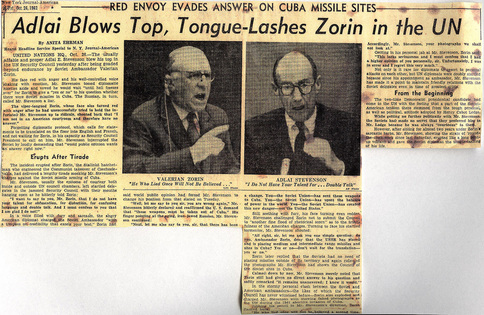Day 8 - October 23

Soviet submarines threaten the naval quarantine by moving into the Caribbean area. Soviet supply ships stop in the water, but the Bucharest tanker carrying petroleum continues through. President Kennedy writes another letter to Khrushchev telling him to halt all Russian ships heading into Cuba. He warns that if an American ship was forced to shoot down a Soviet ship this could start a war between the two superpowers, which would be the most disastrous possible consequence. Khrushchev responds to Kennedy's first letter by saying he isn't asking for a diplomatic solution, but he's rather threatening the Soviet Union by saying if they don't give in to his demands that he will use force.
"You, Mr. President, are not declaring a quarantine, but rather are setting forth an ultimatum and threatening that if we do not give in to your demands you will use force. Consider what you are saying! And you want to persuade me to agree to this! What would it mean to agree to these demands? It would mean guiding oneself in one's relations with other countries not by reason, but by submitting to arbitrariness. You are no longer appealing to reason, but wish to intimidate us."
"You, Mr. President, are not declaring a quarantine, but rather are setting forth an ultimatum and threatening that if we do not give in to your demands you will use force. Consider what you are saying! And you want to persuade me to agree to this! What would it mean to agree to these demands? It would mean guiding oneself in one's relations with other countries not by reason, but by submitting to arbitrariness. You are no longer appealing to reason, but wish to intimidate us."
Day 9 - October 24
Not much happens on October 24 to advance the crisis, other than Kennedy reads Khrushchev's letter and begins working on a response. There is also another daily EXCOMM meeting.
Day 10 - October 25
Knowing that some of missiles were now operational, Kennedy writes another letter to Khrushchev urging him to change the course of action and remove the missile sites. Much debating takes place in the United Nations. The usually courteous U.S. ambassador Adlai Stevenson aggressively confronts Soviet counterpart with photographic evidence of the missiles.

